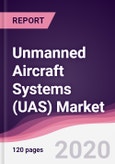Commercial UAS are majorly used by businesses and organizations to enhance their productivity whereas consumer UAS are used by civilians for personal purposes such as photography, videography and recreational purpose as well.
Americas is the leading player in UAS market and it is dominated by Canada in 2017. However, by 2023 the U.S. is expected to dominate Americas UAS market. Americas region is followed by APAC and dominated by Japan and China. China is the largest manufacturer of consumer drones. The total market revenue was valued at $2 billion in 2017 and it is expected to reach $4.5 billion by 2023 at a CAGR estimation of 24.5% in forecast period.
What are Unmanned Aircraft Systems?
Unmanned Aircraft Systems (UAS) also known as drones are air vehicles which operates remotely or fly autonomously without human intervention. Unmanned aircraft systems (UAS) is based on cutting-edge developments in aerospace technologies, offering advancements which may open new and improved civil/ commercial applications as well as improvements to the safety and efficiency of all civil aviation.
What are the major applications for Unmanned Aircraft Systems?
The major applications of these systems include agriculture, law enforcement & public benefit, earth observation, industrial, photography/ videography, real estate as well as education amongst others. In recent past agriculture as well as industrial sectors have been the major end-users of commercial unmanned aircraft systems. On the other hand photography has grown as one of the major application of consumer UAS. The defence systems incorporate drone systems for surveillance and signaling and even for testing their equipment. The innovative use of UAS has been demonstrated in on-air package delivery systems. UAVs are very versatile devices and thus there are unlimited chances for innovative uses being further discovered and explored by scientists and researchers in labs.
Unmanned Aircraft Systems Market
Market Research and Market Trends of Unmanned Aircraft Systems Ecosystem
The Federal Aviation Administration (FAA) is establishing new and modifying existing UAS regulations on drone flights near several U.S. Department of Defense (DoD) sites. The FAA has recently established restrictions for drone flights up to 400 feet within the lateral boundaries of the four sites in California, Texas, Orlando and South Potomac in Indian Head.
Researchers at MIT have developed a virtual-reality training platform by using which smart drones can be fooled into thinking that they are seeing (and learning to navigate around) genuine obstacles despite flying in a wide open empty space. Flight Goggles is a drone hallucination system that is being used by MIT researchers to train drones to fly in complex environments. The prime focus is on improving the speed of action.
Google has deployed a prototype drone control system in a series of tests organized by NASA and the Federal Aviation Administration (FAA). The software uses a number of Google systems for support such as Google maps and can travel over the complex flight paths easily for multiple UAS at the same time. Google unmanned aircraft can adjust routes on the flight to avoid midair collisions. Google has also partnered with the United States Department of Defense to help the agency develop artificial intelligence for analyzing drone footage.
NCDOT’s Division of Aviation Office UAS has undergone a recent partnership with N.C. Emergency Management. Venture is working with the Federal Emergency Management Agency (FEMA) to create a statewide UAS Working Group with local, state and federal governments, and the private sector. The role of NCDOT is to assist N.C. Emergency Management on transportation and infrastructure issues, as well as using the department’s experience with the operation of unmanned aircraft systems. The partnership aims to prepare drone operators in the region of North Carolina in disaster times.
UAVs have a potential for contributing in the concept of smart cities with their involvement. With the latest advances in big data and Internet of Things (IoT), researchers have referred to the previously mentioned concept of swarm of UAVs to use it for urban sensing around the city. Although some UAS can execute automated flights, current regulations require from the UAV companies look to offer operator or another observer always to maintain visual contact. However in an urban setting, where tall buildings are present most of the times, this may complicate operations and therefore their effectiveness.
Who are the Major Players in Unmanned Aircraft Systems market?
The players profiled in the report include Da-Jiang Innovations Science and Technology Co., Ltd. (China), Lockheed Martin Corporation (U.S.), AeroVironment, Inc. (U.S.), Parrot SA (France), SenseFly SA (U.S.), Airborne Innovations LLC, Airbus Aerial, Airgon LLC, Alta Devices, ALX Systems SA, AP Equipment Financing.
What is our report scope?
The report incorporates in-depth assessment of the competitive landscape, product market sizing, product benchmarking, market trends, product developments, financial analysis, strategic analysis and so on to gauge the impact forces and potential opportunities of the market. Apart from this the report also includes a study of major developments in the market such as product launches, agreements, acquisitions, collaborations, mergers and so on to comprehend the prevailing market dynamics at present and its impact during the forecast period 2018-2024.
Key Takeaways from this Report
Evaluate market potential through analyzing growth rates (CAGR %), Volume (Units) and Value ($M) data given at country level – for product types, end use applications and by different industry verticals.
Understand the different dynamics influencing the market – key driving factors, challenges and hidden opportunities.
Get in-depth insights on your competitor performance – market shares, strategies, financial benchmarking, product benchmarking, SWOT and more.
Analyze the sales and distribution channels across key geographies to improve top-line revenues.
Understand the industry supply chain with a deep-dive on the value augmentation at each step, in order to optimize value and bring efficiencies in your processes.
Get a quick outlook on the market entropy – M&A’s, deals, partnerships, product launches of all key players for the past 4 years.
Evaluate the supply-demand gaps, import-export statistics and regulatory landscape for more than top 20 countries globally for the market.
Table of Contents
Methodology

LOADING...








